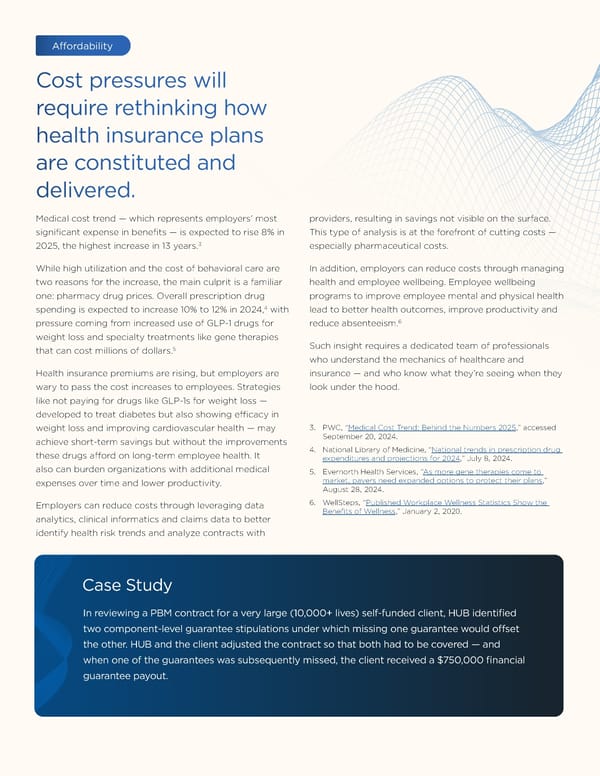Affordability Sustainability Cost pressures will require rethinking how health insurance plans are constituted and delivered. Medical cost trend — which represents employers’ most providers, resulting in savings not visible on the surface. significant expense in benefits — is expected to rise 8% in This type of analysis is at the forefront of cutting costs — 2025, the highest increase in 13 years.3 especially pharmaceutical costs. While high utilization and the cost of behavioral care are In addition, employers can reduce costs through managing two reasons for the increase, the main culprit is a familiar health and employee wellbeing. Employee wellbeing one: pharmacy drug prices. Overall prescription drug programs to improve employee mental and physical health spending is expected to increase 10% to 12% in 2024,4 with lead to better health outcomes, improve productivity and pressure coming from increased use of GLP-1 drugs for 6 reduce absenteeism. weight loss and specialty treatments like gene therapies that can cost millions of dollars.5 Such insight requires a dedicated team of professionals who understand the mechanics of healthcare and Health insurance premiums are rising, but employers are insurance — and who know what they’re seeing when they wary to pass the cost increases to employees. Strategies look under the hood. like not paying for drugs like GLP-1s for weight loss — developed to treat diabetes but also showing efÏcacy in weight loss and improving cardiovascular health — may 3. PWC, “Medical Cost Trend: Behind the Numbers 2025,” accessed achieve short-term savings but without the improvements September 20, 2024. these drugs afford on long-term employee health. It 4. National Library of Medicine, “National trends in prescription drug expenditures and projections for 2024,” July 8, 2024. also can burden organizations with additional medical 5. Evernorth Health Services, “As more gene therapies come to expenses over time and lower productivity. market, payers need expanded options to protect their plans,” August 28, 2024. Employers can reduce costs through leveraging data 6. WellSteps, “Published Workplace Wellness Statistics Show the Benefits of Wellness,” January 2, 2020. analytics, clinical informatics and claims data to better identify health risk trends and analyze contracts with Case Study In reviewing a PBM contract for a very large (10,000+ lives) self-funded client, HUB identified two component-level guarantee stipulations under which missing one guarantee would offset the other. HUB and the client adjusted the contract so that both had to be covered — and when one of the guarantees was subsequently missed, the client received a $750,000 financial guarantee payout. 3
 The Future of Employee Benefits: Strategies for 2025 Page 2 Page 4
The Future of Employee Benefits: Strategies for 2025 Page 2 Page 4